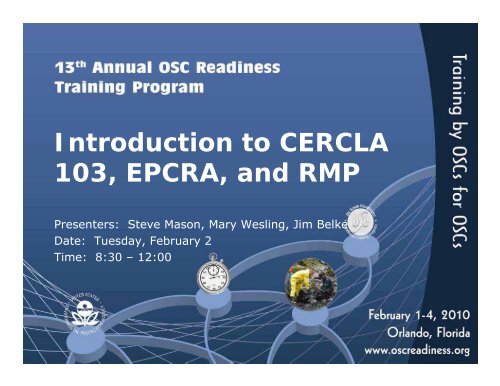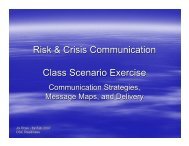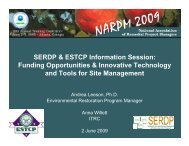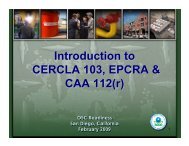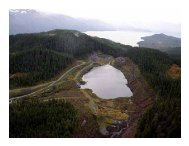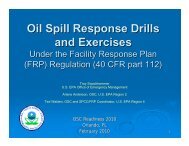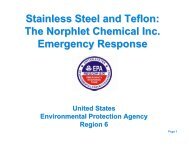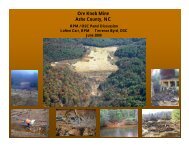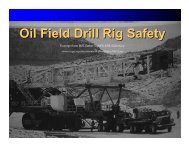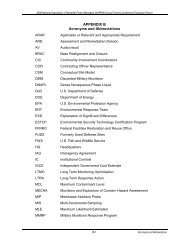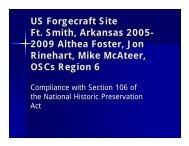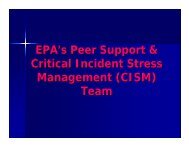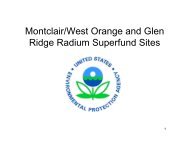Introduction to CERCLA 103, EPCRA, and RMP.pdf
Introduction to CERCLA 103, EPCRA, and RMP.pdf
Introduction to CERCLA 103, EPCRA, and RMP.pdf
Create successful ePaper yourself
Turn your PDF publications into a flip-book with our unique Google optimized e-Paper software.
<strong>Introduction</strong> <strong>to</strong> <strong>CERCLA</strong><br />
<strong>103</strong>, <strong>EPCRA</strong>, <strong>and</strong> <strong>RMP</strong><br />
Presenters: Steve Mason, Mary Wesling, Jim Belke<br />
Date: Tuesday, February 2<br />
Time: 8:30 – 12:00
Course Objectives<br />
• Overview of <strong>CERCLA</strong> section <strong>103</strong>, <strong>EPCRA</strong> & <strong>RMP</strong><br />
• Underst<strong>and</strong> chemical lists & TQs triggering applicability &<br />
common exemptions<br />
• Learn actions that facilities must take <strong>to</strong> comply<br />
• In-depth focus on release reporting & emergency response<br />
requirements<br />
• How this information can benefit OSCs, RSCs, <strong>and</strong> other<br />
response personnel<br />
2
<strong>CERCLA</strong> section <strong>103</strong> –<br />
Notification Requirements
The Basics: Reporting a Release<br />
<strong>CERCLA</strong> Reportable<br />
Release<br />
(Hazardous Substance)<br />
<strong>EPCRA</strong> Reportable Release<br />
(Hazardous Substance or<br />
EHS)<br />
Call NRC<br />
Immediately<br />
(40 CFR §302.6(a))<br />
Call SERC & LEPC<br />
Immediately<br />
(40 CFR §355.40(b)(1))<br />
Newspaper Notice<br />
<strong>CERCLA</strong> §111(g)<br />
Written Follow-up<br />
Emergency Notice<br />
40 CFR 355.40(b)(3)<br />
4
<strong>CERCLA</strong> Notification Requirements<br />
• <strong>CERCLA</strong> §<strong>103</strong> <strong>and</strong> 40 CFR 302.6<br />
oAny person in charge of an … onshore or offshore<br />
facility shall, as soon as he has knowledge of any release<br />
…of a hazardous substance from such … facility in<br />
quantity equal <strong>to</strong> or exceeding the reportable quantity …<br />
in any 24-hour period, immediately notify the NRC<br />
5
Person in Charge<br />
• Facility decides who is in charge … should not be up <strong>to</strong><br />
government<br />
• Normally will be:<br />
ofacility manager<br />
o environmental or safety officer<br />
oSupervisor<br />
• Better not be jani<strong>to</strong>r<br />
6
What is a Facility?<br />
• Under <strong>CERCLA</strong>, a facility is defined as:<br />
o Any building, structure, installation, equipment, pipe or<br />
pipeline, well, pit, pond, lagoon, impoundment, ditch,<br />
l<strong>and</strong>fill, s<strong>to</strong>rage container, mo<strong>to</strong>r vehicle, rolling s<strong>to</strong>ck, or<br />
aircraft…(§101(9))<br />
7
What is a Release?<br />
• Release means any spilling, leaking, pumping, pouring,<br />
emitting, emptying, discharging, injecting, escaping,<br />
leaching, dumping or disposing in<strong>to</strong> the environment…<br />
• A release directly <strong>to</strong><br />
oL<strong>and</strong><br />
oAir<br />
oWater<br />
• A release that is<br />
o Wholly enclosed<br />
o Fertilizer Institute<br />
ruling<br />
8
Aggregating Releases<br />
• All releases of same substance from single facility in<br />
any 24 hour period must be aggregated <strong>to</strong> determine<br />
whether an RQ has been released from facility in<strong>to</strong><br />
the environment (50 FR 13456, 13459; April 4, 1985)<br />
9
What is a Hazardous Substance ??<br />
• <strong>CERCLA</strong> establishes list of<br />
“hazardous substances”<br />
o ≈ 800 specific<br />
substances & 1,500<br />
radionuclides<br />
o Identified under other<br />
statutes: CWA, CAA,<br />
TSCA, RCRA<br />
• 40 CFR 302.4 – List of<br />
Hazardous Substances <strong>and</strong><br />
Reportable Quantities<br />
10
<strong>CERCLA</strong> Hazardous Substances: Hazardous Wastes<br />
• Listed wastes<br />
o Dangerous Waste Discarded Chemical Products – P & U<br />
• Specific commercial chemical products in unused form<br />
• Some pesticides & pharmaceutical products<br />
o Nonspecific Source Wastes – F<br />
• Common manufacturing & industrial processes<br />
• Non-specific sources<br />
o Source Specific Wastes – K<br />
• Specific industries<br />
• Certain sludges & wastewaters from treatment &<br />
production processes<br />
• Unlisted/characteristic wastes<br />
o Ignitability (D001), Corrosivity (D002)<br />
o Reactivity (D003), Toxicity (D004 – D043)<br />
11
<strong>CERCLA</strong> Hazardous Substances:<br />
Hazardous Wastes & the Mixture Rule<br />
• Mixture rule versus RQ for waste listing<br />
o If exact composition of waste stream is known, report<br />
when constituent is released in excess of its RQ<br />
o If exact composition of waste stream is unknown, report<br />
when <strong>to</strong>tal quantity released exceeds RQ for waste<br />
stream listing<br />
12
What’s an RQ ??<br />
• For <strong>CERCLA</strong> substances 5 reportable quantity levels: 1, 10,<br />
100, 1000, 5000 pounds<br />
• No concentration cut-offs<br />
13
Time Period of Release<br />
• Total amount of hazardous substance released within any<br />
24 hour period must be aggregated & compared <strong>to</strong> RQ<br />
• Immediate notification required once RQ is equaled or<br />
exceeded<br />
• Not 24 hours <strong>to</strong> report ! ! ! ! ! !<br />
14
How Fast is Immediate ??<br />
• 1 second … 15 minutes … 1 hour … 24 hours … ???<br />
• Congressional intent<br />
15
Continuous Release Reporting<br />
• Reduced reporting for continuous releases of hazardous<br />
substances that exceed RQ<br />
• Occurs without interruption or abatement, or is<br />
• Routine, anticipated & intermittent during normal<br />
operations or treatment processes<br />
• Stable, predictable & regular in amount & rate of<br />
emission<br />
• Notification given once / follow-up report<br />
• Report statistically significant increases<br />
16
Release Notification: <strong>CERCLA</strong> Exemptions<br />
Petroleum exclusion<br />
Consumer product<br />
Engine exhaust from mo<strong>to</strong>r<br />
vehicles<br />
Nuclear incident<br />
Normal application of<br />
fertilizer<br />
Normal application of pesticide<br />
Federally permitted releases<br />
Solid particles (>100 microns) of<br />
certain metals<br />
Certain radionuclide releases<br />
Releases <strong>to</strong> RCRA Subtitle C<br />
facilities<br />
Qualified NOx Emissions<br />
17
Relationship Between <strong>CERCLA</strong> Liability & Reporting<br />
• Violation of release notification requirements may result in<br />
fines up <strong>to</strong> $37,500 <strong>and</strong> potential prison sentences<br />
• Reporting of release does not preclude liability for cleanup<br />
costs, natural resource damages & costs of any necessary<br />
health studies<br />
• Release below its RQ does not preclude liability from any<br />
damages that may result<br />
18
Emergency Planning <strong>and</strong><br />
Community Right-<strong>to</strong>-Know<br />
Act (<strong>EPCRA</strong>)
Bhopal, India: December 1984<br />
Institute, West Virginia: August 1985<br />
20
<strong>EPCRA</strong><br />
• Emergency Planning Framework & Emergency Response<br />
Planning: Sections 301 & 303<br />
• Emergency Planning Notification: Section 302<br />
• Emergency Release Notification: Section 304<br />
• Hazardous Chemical Inven<strong>to</strong>ry Reporting: Sections 311 &<br />
312<br />
• Toxic Chemical Inven<strong>to</strong>ry Reporting: Section 313<br />
21
What Does LEPC St<strong>and</strong> For ??<br />
a) The Local Environmental Protection Committee<br />
b) The Lost Emergency Planning Commission<br />
c) The Local Emergency Planning Commission<br />
d) The Local Environmental Planning Committee<br />
e) None of the above<br />
22
Where do LEPCs come from ??<br />
• § 301 of <strong>EPCRA</strong> required the State <strong>to</strong> establish Local<br />
Planning Districts <strong>and</strong> appoint an LEPC within each district<br />
• There are over 3,000 LEPCs nationwide<br />
23
Formation of the LEPC<br />
• The LEPC should consist of the following:<br />
• Representatives of elected state <strong>and</strong> local officials<br />
• Law enforcement officials, emergency management<br />
workers, <strong>and</strong> firefighters<br />
• First aid, health, hospital, environmental groups<br />
<strong>and</strong> news media<br />
• Owners <strong>and</strong> opera<strong>to</strong>rs of plants <strong>and</strong> other users of chemicals,<br />
such as hospitals, farms, small businesses<br />
24
Emergency Planning Notification (section 302)<br />
• Applicable <strong>to</strong> any facility that has an Extremely Hazardous<br />
Substance (EHS) present at any time at or above its<br />
Threshold Planning Quantity (TPQ)<br />
• EHSs & their TPQs are codified in 40 CFR part 355<br />
25
Emergency Planning Notification<br />
• Facility Requirements:<br />
• One-time notification <strong>to</strong> SERC & LEPC if EHS present<br />
≥TPQ<br />
o 60 days after facility becomes subject <strong>to</strong> requirements<br />
• Designate facility emergency coordina<strong>to</strong>r<br />
• Provide any information necessary for developing &<br />
implementing local emergency plan<br />
26
Responsibilities of the LEPC<br />
• Develop a plan <strong>to</strong> prepare for <strong>and</strong> respond <strong>to</strong> chemical<br />
emergencies in your district<br />
• Original plan due Oc<strong>to</strong>ber 17, 1988<br />
27
The LEPC plan should:<br />
• Identify facilities <strong>and</strong> routes<br />
• Describe response procedures<br />
• Designate emergency <strong>and</strong> facility<br />
coordina<strong>to</strong>r(s)<br />
• Outline notification procedures<br />
• Describe methods for determining<br />
release <strong>and</strong> affected area<br />
EMERG<br />
• Describe community <strong>and</strong> industry<br />
resources<br />
• Outline evacuation plans<br />
• Describe training program for personnel<br />
• Describe schedules for exercising plans<br />
28
The LEPC Plan<br />
• Plan should be reviewed annually or more frequently if<br />
changes occur<br />
• LEPCs have authority <strong>to</strong> request any information from<br />
facility necessary for developing & implementing emergency<br />
response plan<br />
29
Emergency Release Notification<br />
• Applicable if both of these conditions are met:<br />
o Facility at which hazardous chemical is produced, used<br />
or s<strong>to</strong>red; <strong>and</strong><br />
o which there is release of a reportable quantity (RQ) of<br />
any extremely hazardous substance (EHS) or <strong>CERCLA</strong><br />
hazardous substance<br />
30
Reportable Substances<br />
739<br />
<strong>CERCLA</strong><br />
Hazardous<br />
Substances<br />
59<br />
356<br />
EHSs<br />
31
Emergency Release Notification<br />
• <strong>EPCRA</strong> notification is in addition <strong>to</strong> <strong>CERCLA</strong> release<br />
notification requirements:<br />
o SERC & LEPC (State or area likely <strong>to</strong> be affected by<br />
release)<br />
o Written follow-up of the notification (as soon as<br />
practicable after release)<br />
o Notify 911 or opera<strong>to</strong>r for transportation relatedreleases<br />
(SERC or LEPC phone numbers are not available)<br />
32
Notification includes:<br />
• Chemical name<br />
• Indication of whether substance is extremely hazardous<br />
• Estimate of quantity released in<strong>to</strong> environment<br />
• Time <strong>and</strong> duration of release<br />
• Whether release occurred in<strong>to</strong> air, water, l<strong>and</strong><br />
33
Notification includes:<br />
• Any known or anticipated acute or chronic health risks<br />
• Advice regarding medical attention for exposed individuals<br />
• Proper precautions, such as evacuation or sheltering in<br />
place, <strong>and</strong><br />
• Name <strong>and</strong> telephone number of contact person<br />
34
<strong>EPCRA</strong> section 304 Exemptions<br />
• What is different from <strong>CERCLA</strong>?<br />
oNoPetroleum exclusion (if any EHSs are present in any<br />
petroleum product, notification under <strong>EPCRA</strong> section<br />
304 will apply)<br />
oDo notneed <strong>to</strong> report releases solely within facility<br />
boundaries<br />
• All other <strong>CERCLA</strong> exemptions apply <strong>to</strong> <strong>EPCRA</strong> section 304<br />
35
Release Notification: <strong>EPCRA</strong> Exemptions<br />
Household product<br />
Engine exhaust from<br />
mo<strong>to</strong>r vehicles<br />
Nuclear incident<br />
Normal application of<br />
fertilizer<br />
Release solely within<br />
facility boundaries<br />
Normal application of pesticide<br />
Federally permitted releases<br />
Certain radionuclide releases<br />
Qualified NOx Emissions<br />
36
Hazardous Chemical Reporting<br />
(sections 311 & 312) 40 CFR part 370<br />
Applicability:<br />
• Hazardous Chemicals (chemicals that require an MSDS)<br />
defined under OSHA Hazard Communication St<strong>and</strong>ard<br />
(HCS), which include EHSs<br />
• Exemptions under OSHA HCS<br />
• Exemptions under section 311(e)<br />
• Transportation Exemption (section 327)<br />
37
Reportable Substances<br />
OSHA<br />
Hazardous<br />
Chemicals<br />
> 70,000<br />
356<br />
EHSs<br />
739<br />
<strong>CERCLA</strong><br />
Hazardous<br />
Substances<br />
38
Hazardous Chemical Reporting (sections 311 & 312)<br />
Thresholds:<br />
• EHSs – 500 lbs or TPQ whichever is less<br />
• Gasoline – 75,000 gallons (retail / USTs)<br />
• Gasohol (90% gasoline & 10% ethanol) – 75,000 gallons<br />
(retail / USTs)<br />
• Diesel – 100,000 gallons (retail / USTs)<br />
• All other hazardous chemicals, including alternative fuels –<br />
10,000 lbs<br />
39
Hazardous Chemical Reporting<br />
• Two parts <strong>to</strong> hazardous chemical reporting:<br />
o Material safety data sheet (MSDS) reporting<br />
• One-time reporting requirement<br />
o Hazardous chemical inven<strong>to</strong>ry reporting<br />
• Annual hazardous chemical inven<strong>to</strong>ry due by March 1<br />
40
Hazardous Chemical Reporting (section 311)<br />
Requirements:<br />
• Submit MSDS or list of chemicals grouped by hazard<br />
category above thresholds <strong>to</strong>:<br />
o State Emergency Response Commission (SERC)<br />
o Local Emergency Planning Committee (LEPC)<br />
o Local Fire Department with jurisdiction over facility<br />
• One-time submission<br />
• Supplemental Reporting – new chemicals & significant new<br />
information – within 3 months<br />
41
Hazardous Chemical Reporting (section 312)<br />
• Section 312 – Submit Inven<strong>to</strong>ry form (Tier I/Tier II or<br />
State form – paper form) for all chemicals present at<br />
facility at any time during previous calendar year above<br />
thresholds.<br />
• Report is due March 1 annually<br />
oSERC<br />
oLEPC<br />
o Local fire department with jurisdiction over facility<br />
• Tier2 Submit or State Electronic format<br />
42
Tier II form (section 312)<br />
43
Toxic Release Inven<strong>to</strong>ry (section 313)<br />
• Begun in 1988, TRI contains information on<br />
releases of nearly 650 chemicals <strong>and</strong> chemical<br />
categories from industries including<br />
manufacturing, metal <strong>and</strong> coal mining, electric<br />
utilities, <strong>and</strong> commercial hazardous waste<br />
treatment, among others<br />
44
TRI Reporting Process<br />
Covered Primary<br />
SIC Code(s) or<br />
Federal facility?<br />
NO<br />
YES<br />
Ten Employees?<br />
(20,000 hours)<br />
YES<br />
MPOU*<br />
Section 313<br />
Chemicals?<br />
NO<br />
NO<br />
STOP<br />
YES<br />
MPOU*<br />
Thresholds<br />
Exceeded?<br />
NO<br />
YES<br />
Reporting Thresholds Met; Form R/Form A Required<br />
*MPOU: Manufacture (including import), process, or otherwise use<br />
45
Covered SIC codes (now NAICS)<br />
Industrial Sec<strong>to</strong>r Primary SIC Code<br />
Manufacturing 20-39<br />
Metal mining 10 (except 1011, 1081, <strong>and</strong> 1094)<br />
Coal mining 12 (except 1241)<br />
Electrical utilities 4911, 4931, <strong>and</strong> 4939, limited <strong>to</strong> facilities that<br />
combust coal <strong>and</strong>/or oil for the purpose of generating<br />
electricity for distribution in commerce<br />
Treatment, 4953, limited <strong>to</strong> RCRA Subtitle C permitted or interim<br />
S<strong>to</strong>rage, <strong>and</strong> status facilities<br />
Disposal facilities<br />
Solvent recovery 7389, limited <strong>to</strong> facilities primarily engaged in solvent<br />
services<br />
recovery services on a contract or fee basis<br />
Chemical 5169<br />
distribu<strong>to</strong>rs<br />
Petroleum bulk 5171<br />
terminals<br />
46
Reportable Substances<br />
OVER 600<br />
TRI<br />
Chemicals<br />
739<br />
<strong>CERCLA</strong><br />
Hazardous<br />
Substances<br />
228<br />
79<br />
21<br />
59<br />
356<br />
EHSs<br />
47
Thresholds<br />
• non-PBT Section 313 chemical<br />
o Manufactured (including imported) more than 25,000<br />
pounds per year, or<br />
o Processed more than 25,000 pounds per year, or<br />
o Otherwise used more than 10,000 pounds per year<br />
• Threshold calculations are based on cumulative quantities<br />
per Section 313 chemical over the reporting year<br />
48
Thresholds<br />
• Persistent, bioaccumulative, <strong>and</strong> <strong>to</strong>xic (PBT) threshold<br />
quantity is:<br />
Type of Chemical<br />
Reporting Threshold, by Activity<br />
Manufacture<br />
Process<br />
Otherwise use<br />
Highly persistent <strong>and</strong><br />
bioaccumulative<br />
compounds<br />
10 pounds<br />
10 pounds<br />
10 pounds<br />
Dioxin <strong>and</strong> dioxin-like<br />
compounds<br />
0.1 grams<br />
0.1 grams<br />
0.1 grams<br />
Other persistent <strong>and</strong><br />
bioaccumulative<br />
compounds (lead <strong>and</strong><br />
lead compounds)<br />
100 pounds<br />
100 pounds<br />
100 pounds<br />
49
Reporting<br />
Submit TRI reports <strong>to</strong> U.S. EPA, <strong>and</strong> either<br />
• designated state officials, or<br />
• designated tribal office<br />
by July 1st following the calendar year’s activities<br />
[e.g. July 1, 2010 deadline for RY 2009 activities]<br />
50
TRI Process<br />
Applicability &<br />
Threshold Determinations<br />
Identify Section<br />
313 chemicals<br />
manufactured,<br />
processed, or<br />
otherwise used at<br />
the site<br />
Determine<br />
quantities of<br />
Section 313<br />
chemicals <strong>and</strong><br />
whether they are<br />
manufactured,<br />
processed, or<br />
otherwise used<br />
on-site for the<br />
reporting year<br />
Release/Waste Mgmt. Reporting<br />
Identify <strong>to</strong>tal<br />
releases <strong>and</strong><br />
off-site transfers<br />
Identify other waste<br />
management<br />
practices<br />
Use TRI-ME <strong>to</strong><br />
Complete<br />
Form R or Form A<br />
If a Threshold is<br />
Exceeded…<br />
Identify pollution<br />
prevention<br />
activities<br />
Complete<br />
Final QA/QC<br />
Submit <strong>to</strong><br />
EPA & State<br />
51
Form R Content<br />
Part I<br />
Section 1:<br />
Section 2:<br />
Section 3:<br />
Section 4:<br />
Section 5:<br />
Reporting Year<br />
Trade Secret Information<br />
Certification<br />
Facility Identification<br />
Parent Company Info<br />
Part II<br />
Section 1:<br />
Section 2:<br />
Section 3:<br />
Section 4:<br />
Section 5:<br />
Section 6:<br />
Section 7:<br />
Section 8:<br />
Toxic Chemical ID<br />
Mixture Component ID<br />
Activities & Uses<br />
Max Amt on site for CY<br />
On-site Releases<br />
Off-site Releases<br />
On-site Waste Treatment, Energy Recovery, Recycling Processes<br />
Source Reduction <strong>and</strong> Recycling Activities<br />
52
Public Availability (section 324)<br />
• Each emergency response plan, material safety data sheet,<br />
list described in section 311(a)(2), inven<strong>to</strong>ry form & followup<br />
emergency notice shall be made available <strong>to</strong> general<br />
public shall be consistent with section 322 (Trade Secrets)<br />
53
Conclusion: <strong>EPCRA</strong> has two main purposes<br />
• <strong>to</strong> support planning for responding <strong>to</strong> accidents; <strong>and</strong><br />
• <strong>to</strong> provide community with data about potential chemical<br />
hazards<br />
• For law <strong>to</strong> work, industry, citizens, <strong>and</strong> government at<br />
all levels must work <strong>to</strong> plan for accidents <strong>and</strong> <strong>to</strong> reduce<br />
risk from releases<br />
54
How this information assists OSCs, RSCs, <strong>and</strong><br />
other responders<br />
• Chemical information during a response<br />
• Emergency Planning for large disasters<br />
• Trends in releases<br />
• Geographic areas<br />
• Causes<br />
• Effects<br />
• Enforcement<br />
55
Questions?<br />
56
Clean Air Act (CAA)<br />
Section 112(r)<br />
Risk Management Program
Risk Management Program<br />
40 CFR Part 68<br />
• The Risk Management<br />
Program (<strong>RMP</strong>) is designed<br />
<strong>to</strong>:<br />
o Prevent accidental chemical<br />
releases <strong>to</strong> air<br />
o Minimize the consequences of<br />
releases that do occur<br />
o Provide information about chemical<br />
hazards <strong>to</strong> public & government<br />
officials<br />
58
Legislative Background<br />
• Clean Air Act Amendments (1990)<br />
o Process Safety Management<br />
St<strong>and</strong>ard – PSM (1992)<br />
o Risk Management Program Regulation<br />
(1994-1996)<br />
o U.S. Chemical Safety <strong>and</strong> Hazard Investigation<br />
Board – CSB (1998)<br />
o Chemical Safety Information, Site Security,<br />
<strong>and</strong> Fuels Regula<strong>to</strong>ry Relief Act –<br />
CSISSFRRA (1999)<br />
59
Clean Air Act section 112(r)<br />
• CAA 112(r)(1) established General Duty<br />
Clause<br />
• CAA 112(r)(7) required EPA <strong>to</strong>:<br />
o List at least 100 regulated substances<br />
(140 now listed)<br />
o Develop regulations <strong>and</strong> guidance <strong>to</strong><br />
prevent, detect & respond <strong>to</strong> accidental releases<br />
o Manage risk management plans (<strong>RMP</strong>s) submitted by<br />
facilities & <strong>to</strong> make plans available <strong>to</strong> government<br />
officials & public<br />
60
General Duty Clause<br />
• Owners & opera<strong>to</strong>rs have a<br />
general duty <strong>to</strong>:<br />
o Identify hazards associated with<br />
potential accidental release<br />
o Design & maintain safe facility<br />
o Minimize consequences of<br />
accidental releases<br />
• Not limited <strong>to</strong> specific list of<br />
chemicals or threshold<br />
quantities<br />
61
<strong>RMP</strong> Regulated Substances<br />
• 77 <strong>to</strong>xic & 63 flammable substances<br />
• Toxic mixtures w/ >1% listed <strong>to</strong>xic substance <strong>and</strong><br />
partial pressure > 10 mm Hg<br />
• Flammable mixtures w/ >1% listed flammable<br />
substance in mixture exceeding NFPA 4 flammability<br />
criteria<br />
• Substances with specified concentrations:<br />
o Nitric Acid (≥80%)<br />
o Hydrofluoric Acid (≥50%)<br />
o Hydrochloric Acid (≥37%)<br />
o Aqueous Ammonia (≥20%)<br />
62
Geographic Distribution of <strong>RMP</strong> Facilities<br />
63
<strong>RMP</strong> Chemical Processes<br />
~ 14,000 facilities with<br />
~ 19,000 processes containing<br />
~ 24,000 vessels<br />
All<br />
Others<br />
Isobutane<br />
Ammonia<br />
34%<br />
Pentane<br />
Formaldehyde<br />
(so)<br />
Isopentane<br />
Butane<br />
2%<br />
Ammonia (aq)<br />
2%<br />
Sulfur Dioxide<br />
3%<br />
Flammable<br />
Mixture<br />
13%<br />
Chlorine<br />
16%<br />
Hydrogen<br />
Fluoride<br />
All Others<br />
Propane<br />
4%<br />
64
<strong>RMP</strong> Chemical Quantities<br />
Propylene<br />
1%<br />
Ethane<br />
2%<br />
Ethylene<br />
2%<br />
Isobutane<br />
3%<br />
There are over 75 billion<br />
pounds of hazardous<br />
chemicals regulated<br />
under the <strong>RMP</strong> rule<br />
2-Methylpropene<br />
Pentane<br />
Butane<br />
11%<br />
Ammonia<br />
13%<br />
Propane<br />
14%<br />
Flammable Mixture<br />
43%<br />
Chlorine<br />
Vinyl Chloride<br />
1,3-Butadiene<br />
All Others<br />
65
<strong>RMP</strong> Industry Sec<strong>to</strong>rs<br />
Other 5%<br />
Food &<br />
Beverage<br />
14%<br />
Agriculture<br />
28%<br />
Water &<br />
Wastewater<br />
16%<br />
Energy<br />
16%<br />
Chemical<br />
Manufacturing<br />
21%<br />
66
What Facilities Are Subject <strong>to</strong> <strong>RMP</strong>?<br />
• Facilities meeting all of following criteria are<br />
subject <strong>to</strong> 40 CFR Part 68:<br />
o Stationary source<br />
o With one or more regulated substances<br />
o Contained in a process<br />
o Above a threshold quantity<br />
67
<strong>RMP</strong> Regulation – Requirements<br />
• Offsite consequence<br />
analysis<br />
• Five-year accident his<strong>to</strong>ry<br />
• Accident prevention<br />
program (most facilities)<br />
• Emergency response<br />
program<br />
• Risk Management Plan<br />
(<strong>RMP</strong>)<br />
68
Off-site Consequence Analysis – Simplified Example<br />
Source has:<br />
2 regulated Toxic substances<br />
1 regulated Flammable substance<br />
B Avenue<br />
C Avenue<br />
Flammable WCS<br />
Source Boundary<br />
“Toxic B” ARS 2<br />
“Toxic A” ARS 1<br />
A Street<br />
Rail Spur<br />
“Toxic A” WCS distance <strong>to</strong> endpoint<br />
0 1/2 1<br />
Miles<br />
69
One Process<br />
Process vs.<br />
Worst Case<br />
Worst case<br />
70
One Process<br />
Worst case<br />
71
3 Prevention Program Levels<br />
Recep<strong>to</strong>rs<br />
in worstcase<br />
footprint?<br />
Yes<br />
Subject<br />
<strong>to</strong> OSHA<br />
PSM?<br />
No<br />
Listed<br />
NAICS<br />
code?<br />
No<br />
Program<br />
2<br />
No Yes Yes Yes<br />
Off site<br />
impact<br />
due <strong>to</strong> a<br />
release?<br />
<strong>RMP</strong>,<br />
Prevention<br />
Program, ER<br />
Planning<br />
No<br />
Program<br />
1<br />
<strong>RMP</strong>, ER<br />
Planning<br />
Program<br />
3<br />
<strong>RMP</strong>,<br />
Prevention<br />
Program, ER<br />
Planning<br />
72
Risk Management Plans<br />
• Executive summary<br />
• Registration info: Facility ID, location, lat/long,<br />
chemical process info (e.g., NAICS, chemical<br />
name, CAS #, quantity), etc.<br />
• 5-year accident his<strong>to</strong>ry<br />
• Accident prevention program info:<br />
hazard analysis methods,<br />
mitigation measures, etc. (P2 & P3)<br />
• Emergency response planning<br />
information<br />
• Offsite consequence analysis: Worst-case &<br />
alternative release scenarios<br />
73
Prevention Program<br />
Program 2 Program 3<br />
• Safety information<br />
• Hazard review<br />
• Operating procedures<br />
• Training<br />
• Maintenance<br />
• Compliance audits<br />
• Incident investigation<br />
• Process safety<br />
information<br />
• Process hazard analysis<br />
• Operating procedures<br />
• Training<br />
• Mechanical integrity<br />
• Management of change<br />
• Pre-startup review<br />
• Compliance audits<br />
• Employee participation<br />
• Hot work permit<br />
• Contrac<strong>to</strong>rs<br />
74
Process Safety Information<br />
• Hazardous effects of inadvertent<br />
mixing of different materials<br />
• Piping & Instrument Diagrams<br />
(P&IDs) (complete & up-<strong>to</strong>-date)<br />
• Process upper/lower temperature<br />
& pressure limits<br />
• Relief/ventilation system design<br />
basis<br />
75
Operating Procedure Requirements<br />
Steps for Each Phase Program 2 Program 3<br />
Initial startup <br />
Normal operations <br />
Temporary operations <br />
Emergency shutdown <br />
Emergency operations <br />
Normal shutdown <br />
Start-up following a normal or emergency<br />
shutdown or major change<br />
Lockout/tagout<br />
Confined space entry<br />
Opening process equipment or piping<br />
Entrance in<strong>to</strong> the facility<br />
<br />
<br />
<br />
<br />
<br />
<br />
76
Operating Procedure Requirements<br />
Operating Limits Program 2 Program 3<br />
Consequences of deviations <br />
Steps <strong>to</strong> avoid, correct deviations <br />
Safety & Health Considerations Program 2 Program 3<br />
Chemical properties & hazards<br />
Precautions for preventing chemical<br />
exposure<br />
Control measures for exposure<br />
QC for raw materials <strong>and</strong> chemical inven<strong>to</strong>ry<br />
Special or unique hazards<br />
Safety Systems & Their Functions Program 2 Program 3<br />
What systems are there <strong>and</strong> how do they<br />
work<br />
Annual Certification Requirement Program 2 Program 3<br />
Conduct annual certification<br />
<br />
<br />
<br />
<br />
<br />
<br />
<br />
77
Mechanical Integrity Program -<br />
Critical Elements<br />
• Equipment & design-specific process safety<br />
information<br />
• Written maintenance procedures<br />
• Training for process maintenance activities<br />
• Inspection & testing<br />
• Correction of deficiencies in equipment that are<br />
outside acceptable limits<br />
• Development of a quality assurance program<br />
78
Mechanical Integrity<br />
79
Management of Change Procedures<br />
• A change is a modification <strong>to</strong><br />
o<br />
o<br />
o<br />
Process equipment or instrumentation<br />
Technology, procedures, raw<br />
materials, or<br />
Processing conditions<br />
• A change is NOT “Replacement in<br />
kind” which means a replacement<br />
that “satisfies the design<br />
specifications”<br />
80
Emergency Response<br />
Program<br />
• Program 1 processes: Owner/opera<strong>to</strong>r<br />
must ensure that they have coordinated<br />
with local response agencies <strong>and</strong> their<br />
facility is included in community<br />
response plan<br />
• Program 2 & 3 processes: Requirements<br />
depend on whether facility uses its own<br />
employees <strong>to</strong> respond <strong>to</strong> accidental<br />
releases<br />
81
ER Program: Non-Responding<br />
Facilities<br />
• Facilities that rely on public responders must<br />
have:<br />
o An Emergency Action Plan<br />
o Appropriate notification mechanisms in place<br />
o Coordinated response actions with community<br />
ER plan or local fire department<br />
82
ER Program:<br />
P2 & P3 Responding Facilities<br />
• Facilities that use their own employees <strong>to</strong><br />
respond <strong>to</strong> accidental releases must have:<br />
o Written ER plan addressing response procedures,<br />
medical treatment, public & local authority<br />
notification<br />
o ER equipment inspection,<br />
testing & maintenance<br />
o Training for all employees<br />
in relevant procedures<br />
83
Common “Problem”…<br />
• Facilities say they have invited responders<br />
<strong>to</strong> their facility for exercise/walk-thru, but<br />
…no takers….<br />
84
A Better ER Plan<br />
Door<br />
Engine<br />
Room<br />
Product S<strong>to</strong>rage<br />
Wind Direction<br />
Office<br />
Employee<br />
Gathering<br />
Area<br />
85
Off<br />
Shut-off valve<br />
86
<strong>RMP</strong> Reported Accidents<br />
500<br />
400<br />
300<br />
200<br />
100<br />
0<br />
'95 '96 '97 '98 '99 '00 '01 '02 '03 '04 '05 '06 '07 '08 '09<br />
# Accidents<br />
87
Teamwork!!!!<br />
Responders<br />
Industry<br />
Community<br />
Local State Federal<br />
88
Where do you find the info?<br />
89
Questions?<br />
• For more information, visit:<br />
www.epa.gov/emergencies<br />
90


